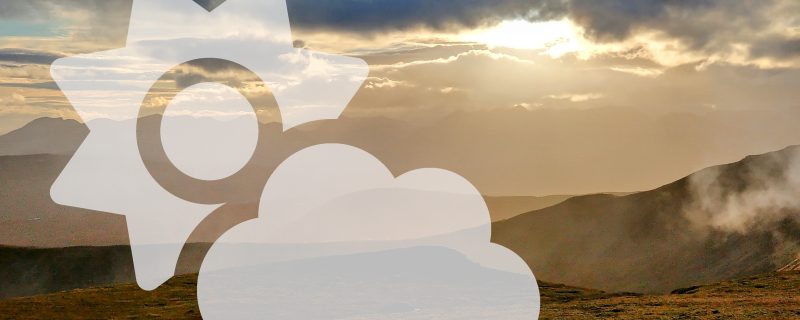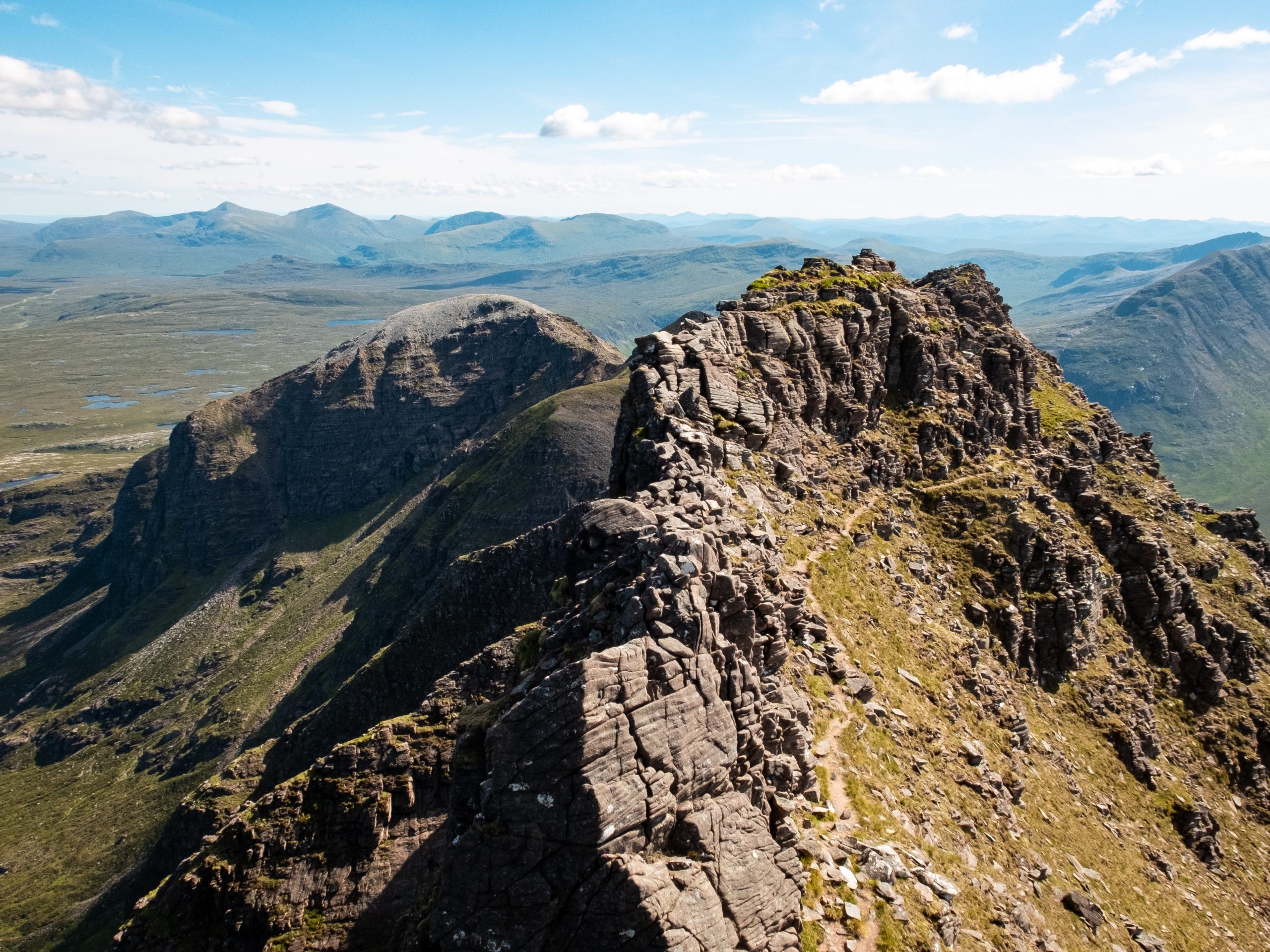
The Corrag Bhuidhe Pinnacles of An Teallach
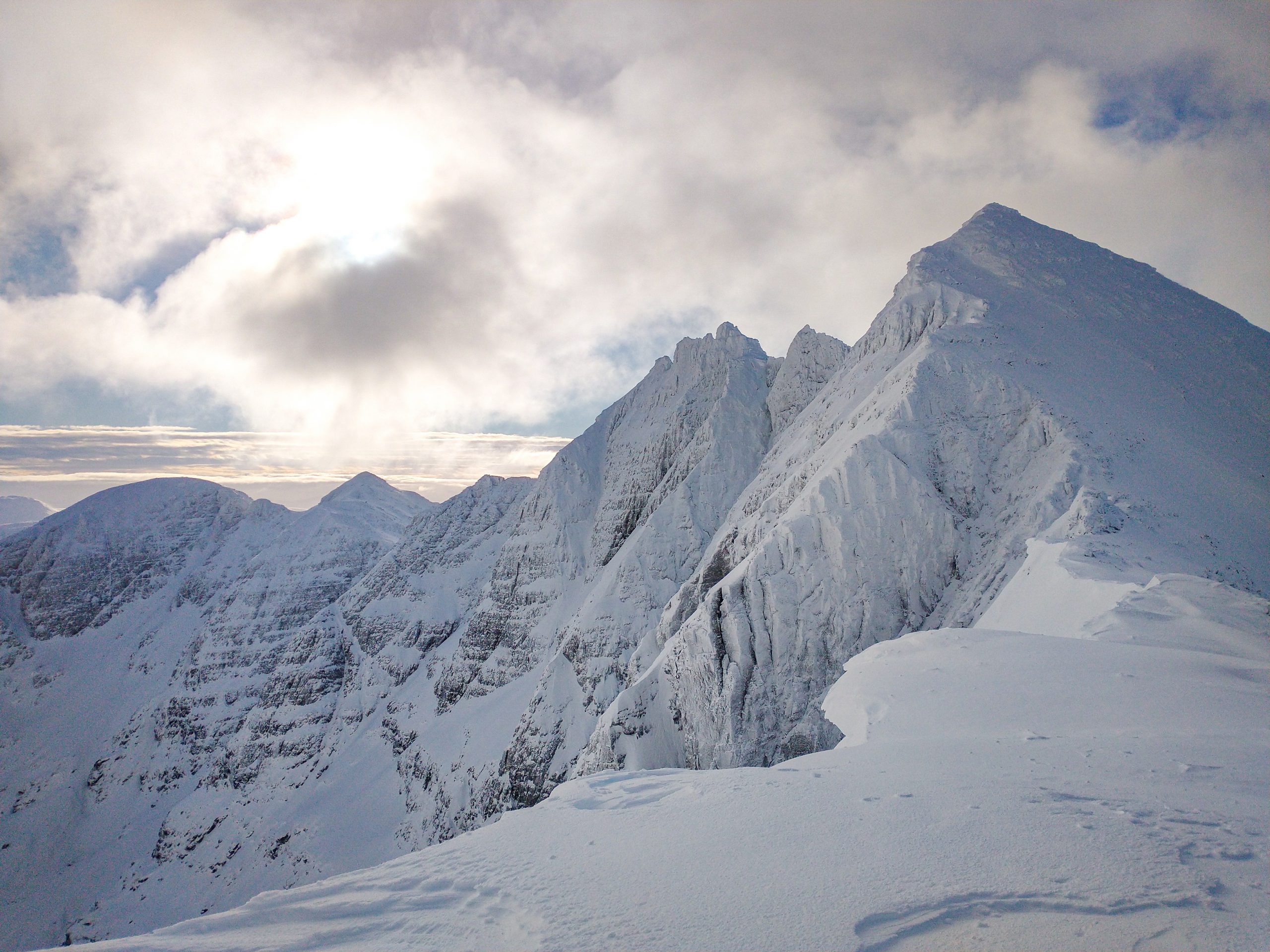
An Teallach in winter after a January snow storm
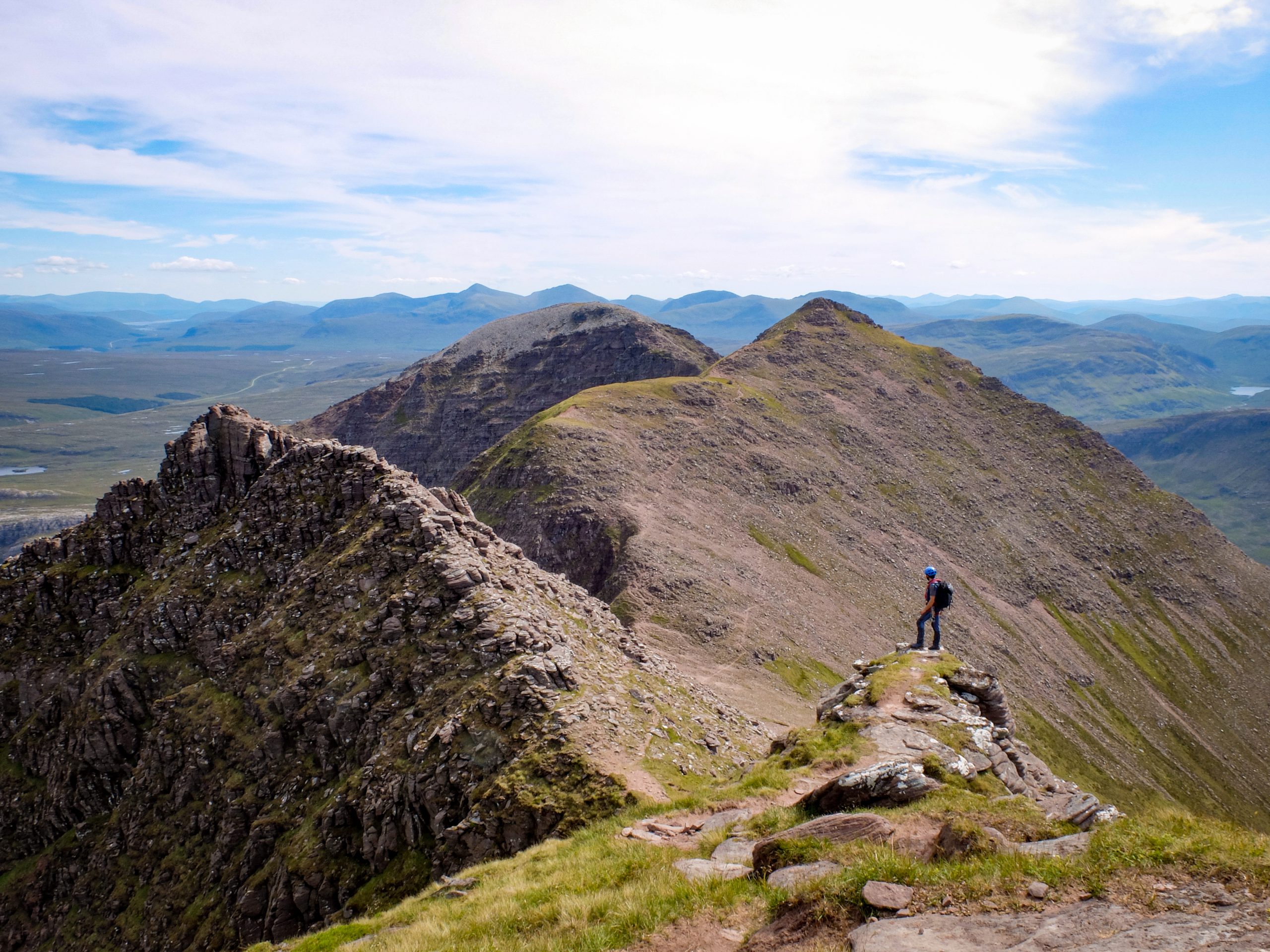
Looking south to Sail Liath and Cadha Gobhlach
An Teallach is one of the finest mountains in the UK. It stands in the North West Highlands of Scotland and enjoys impressive views. Looking out across the sea to the Hebrides in one direction and to the great northwest mountain ranges of the Fisherfields, Fannichs and Beinn Dearg hills in the other. This wild and remote mountain ridge is famed for its two munros; Sgurr Fiona (1060m) and Bidean a Ghlas Thauill (1062m), as well as the Corag Buidhe Pinnacles. The latter is an airy set of spires leading from Sgurr Fiona with drops off 500m and 800m either side. The eastern flank of the mountain is divided into two major corries. Both of which provide fantastic winter routes and spectacular scenery at any time of year.
View some of the routes we can offer on this mountain
Climb Torridon provides private guiding on An Teallach as well as other remote mountains in the North West Highlands and Torridon. We are a local company and pride ourselves on our intricate knowledge of this fantastic mountain. Our expert guides can help you to achieve your own personal goals on An Teallach. That might include exhilarating scrambling over the sandstone pinnacles of Corrag Buidhe, hunting for geocaches on its higher slopes or taking photos of the dramatic mountain scenery. When you book with us we will discuss your needs and tailor the day around you.
See our ratios and pricing information
An Teallach is a remote mountain located in the beautiful North West Highlands. The Dundonnell Hotel sits at the foot of the mountain providing a great base for an ascent. If you prefer access to a few more facilities, the local towns of Gairloch and Ullapool have shops, accommodation, restaurants and other attractions. Both are approximately 40 minutes drive to Dundonnell and are ideal locations for exploring the local area, as well as An Teallach itself.
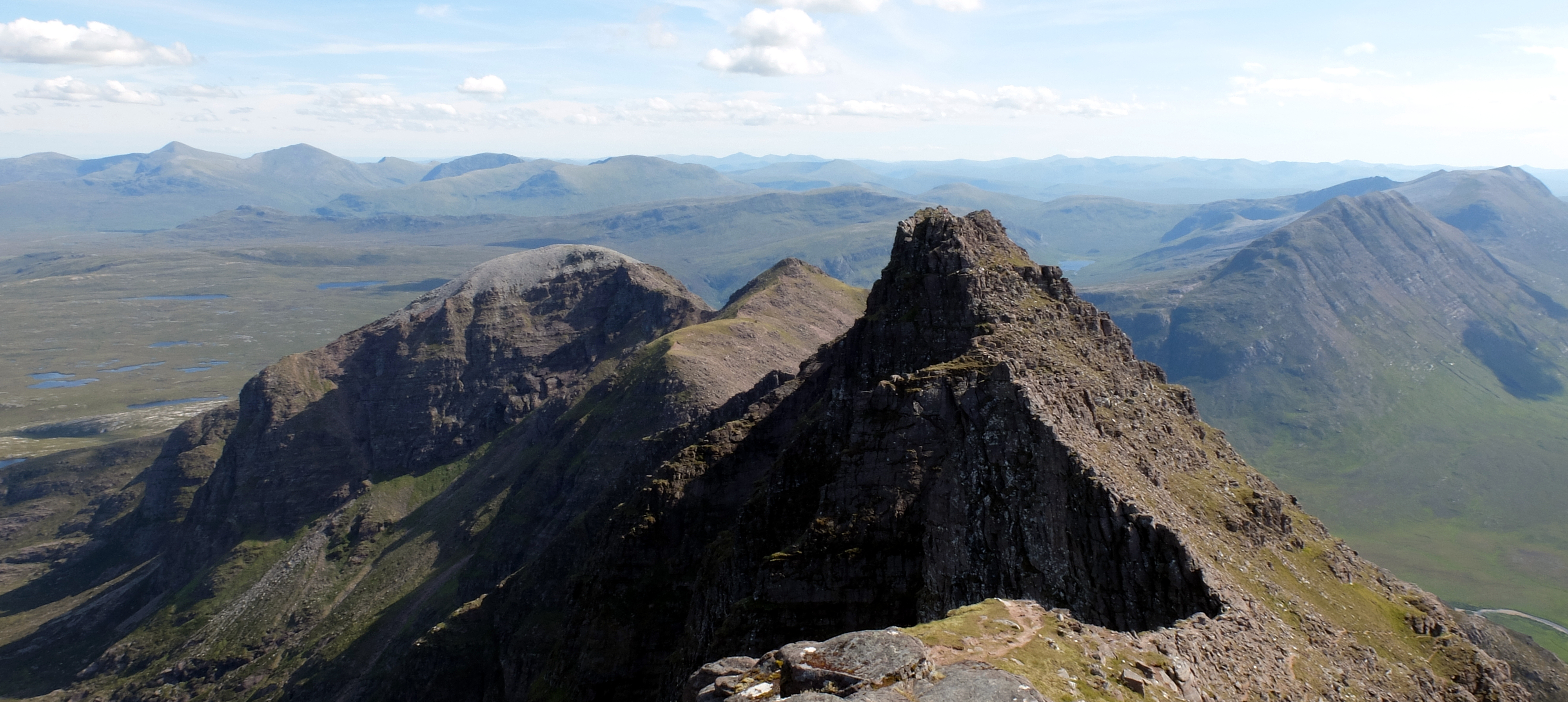
There are a variety of routes, climbs and scrambles to be enjoyed on An Teallach. We can guide any of the options below or let us know if you have a bespoke idea in mind.
A complete traverse of the ridge is a spectacular day out and our most popular option. Starting at Corrie Hallie this route includes summiting both Munros (Sgurr Fiona and Bidean a Ghlas Thauill) and scrambling along The Corag Buidhe Pinnacles. We will then descend down to Dundonnell to complete the day.
This option is more popular with Munro baggers or those wishing to avoid the scrambling. Starting in Dundonnell, we will summit both the Munros, Sgurr Fiona and Bidean a Ghlas Thauill, before returning the same way without tackling The Corag Buidhe Pinnacles. This provides the simplest method to gain the summits, however it shouldn’t be underestimated as it involves wild open mountain country.
In winter the mountain is transformed to an alpine peak and the full traverse becomes a mountaineers dream. In winter conditions we can offer all the routes above and so much more. The many fine routes out of each of its corries offer an array of winter climbing. Whether you wish to summit the Munros, complete a full winter traverse or experience some of the world class winter climbing just let us know.
We have an intimate knowledge of this mountain and there are many possible alternative routes. For example, an alternative descent can be made via Corrie a Glas Tholl, or the full traverse can be done in an anticlockwise direction. Should you have a specific route or requirement just let us know, we will be very happy to help.
Locally, An Teallach is pronounced with the “T” as a “ch” sound, and the ending “ach” as an “ak” sound. The emphasis being on the middle CHAL syllable. Therefore, it is pronounced, “an-CHAL-ak.
An Teallach means “The Forge” in Scottish Gaelic. There are some references that it may mean ‘The Anvil’, however, it is commonly considered that “The Forge” is more likely the correct translation. Additionally, it is thought that the mountain’s name originates more from the colouring of An Teallach rather than its shape. It’s dark, grey rock closely resembling the colour of metal on a blacksmith’s forge.
It is located near the small hamlet of Dundonnel. There is a hotel here, as well as a Mountain Rescue base, but very little else. The nearest villages of any size would be Autlbea to the West (18 miles away) and Ullapool to the North (25 miles away). If you are here to do this mountain alone, either Dundonnel, Aultbea or Ullapool would be good places to locate yourself. With Ullapool being the area with the most facilities. Alternatively, we commonly recommend Gairloch as another fantastic option. Gairloch is 30 miles away, but based between An Teallach and the Torridon mountains, providing fantastic access to either. It is also a village with excellent local facilities, including a variety of hotels, pubs, shops etc. The nearest city is Inverness (approximately 60 miles away).
It is not simple to get to An Teallach without a car. The nearest airport is Inverness (approximately 60 miles away). From here you can get to the nearest train station, which is Garve, approximately 30 miles from Ullapool. Once in Garve you can get a bus to Ullapool or Braemore Junction. From either of these locations there is no public transport, but you could use a local taxi service. Alternatively, you could get the train to Achnasheen. There is a train between Inverness and Achnasheen and then there is a bus from Achnasheen to Gairloch. From Gairloch there is no public transport, however, there is a local taxi service. Either way, due to the infrequency of the train and bus, careful planning would be needed.
We usually find it takes within the region of ten hours to guide An Teallach with most of our customers. Obviously, this depends on the weather, group fitness and ability. It should not be underestimated; it is definitely a big day out.
There are two Munros on An Teallach, Sgurr Fiona (1060m) and Bidean a Ghlas Thauill (1062m).
There are seven Munro Tops on An Teallach (please do note, these are different from Munros). They are; Sail Liath, Stob Cadha Gobhlach, Corrag Bhuidhe, Lord Berkeley’s Seat, Sgurr Creag An Eich, Glas Mheall Liath, Glas Mheall Mor.
The highest point is the summit of Bidein a’ Ghlas Thuill at 1062 metres.
According to our mapping app, Outdoor Active, the total distance of our guided An Teallach Traverse route is 16.3km
According to our mapping app, Outdoor Active, the total amount of height gain on our guided An Teallach Traverse is 1377 metres.
Yes, during your traverse on An Teallach your guide will use a rope in conjunction with harnesses to keep you safe on the scrambling sections of the route. Additionally, a helmet will be used to help protect you from any loose or falling rock. A minority of mountaineers who undertake an An Teallach traverse independently, may choose to not use a rope. This may be dependent upon their experience level, available equipment and exact route taken. However, the majority of people who complete the traverse, whether guided or independent, will use a rope, harness and helmet for safety purposes.
An Teallach is a grade three scramble. A grade three scramble is generally considered to be a high level of difficulty of scrambling. Grade three scrambles generally have the following characteristics:
This is a very subjective question, so there is no simple answer. Every individual will find different elements of mountaineering challenging or simple. What is easy for one person can be extremely difficult for another. However, to try and provide a general understanding, An Teallach is considered one of the most challenging mountains in Scotland. This is due to a combination of the grade of scrambling along with the overall physical demands of the day, both in regards to the total length and ascent. We often are asked to compare An Teallach to other famous mountains and scrambles throughout the UK. Therefore, we have listed some comparisons below. Please do keep in mind that since everyone is different, people’s opinions may vary.
Yes, there are multiple bypass paths around some of the sections of scrambling. Some of which simply end up as a deadend. Therefore, your An Teallach guide will know which of the bypass paths are more suitable should you prefer to use them.
It is worth being aware that the bypass paths are exposed. They can be slippery and eroded with large drops. We have customers who are understandably nervous of the scrambling on An Teallach and ask if we can guide them along the bypass to reduce the difficulty. Whilst this is something we can certainly do, please keep in mind this is still an airy and awkward path. If you are nervous of scrambling but wish to complete the An Teallach Traverse, just let us know. Our guides are very understanding and will explain the differences in the two approaches in detail, in order to help you decide on the best route for you.
Please, don’t hesitate to contact us with any questions you have at all. Whether you are looking to use us as your An Teallch guide or you are planning on attempting the mountain independently. We are happy to do our best to answer any questions. We also update this page regularly with any additional questions we receive.
In order to provide the highest level of experience and safety we maintain low ratios for guided ascents. Below you can see the details. All trips are considered private bookings so you will not have to worry about the pace of others and will get a trip tailored to your individual needs.
| Ratio | Price |
|---|---|
| 1:1 | £300 |
| 1:2 | £160 per person |
| 1:3 | £120 per person |
| 1:4 | £100 per person |
| Ratio | Climbing & Traverse Price | Walking (E.g. Munros Only) |
|---|---|---|
| 1:1 | £320 | £300 |
| 1:2 | £170 per person | £160 per person |
| 1:3 | N/A * | £120 per person |
| 1:4 | N/A * | £100 per person |
An Teallach is a remote mountain. All days on this hill require a high level of fitness. This is particularly true in winter, where it can be considered one of the great challenges in the UK to which many mountaineers aspire. At any time of year expect around 10 hours or more for a complete traverse with ascent of over 1000m from sea level. All that said it is definitely an achievable mountain for the keen walker. If you have concerns over your fitness to complete this mountain then please don’t hesitate to get in touch and we can discuss your particular circumstances.
You will need normal hill walking kit including sturdy footwear, waterproofs (jacket and trousers), food and warm clothing. Technical kit is available to borrow for your booking where required. Alternatively, you are welcome to bring your own subject to inspection by your guide to ensure its safety. A complete kit list is provided with each booking.
